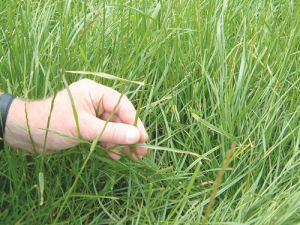More farmers renewing pasture – still more to go
Renewing 10% of New Zealand farm pasture annually would ensure productivity and performance gains achieved via new species do not dwindle over a 10-year cycle.
 Pasture renewal rates throughout NZ are very low – at around 2.5% for sheep and beef farms and only 8% for dairy farms.
Pasture renewal rates throughout NZ are very low – at around 2.5% for sheep and beef farms and only 8% for dairy farms.
Despite plenty of evidence showing the clear benefits of renewing pastures, renewal rates in New Zealand remain very low, claims the Pasture Renewal Charitable Trust.
“Pasture renewal rates nationwide are very low – around 2.5% for sheep and beef farms and only 8% for dairy farms,” says the trust’s project manager Tim Wood.
“Yet there are plenty of reasons and evidence available to suggest it is beneficial to renew older pastures.”
Wood says though research shows many farmers know the benefit of planting new pastures, many perceive barriers, including: it is expensive; new grasses don’t persist; they need greater maintenance; it is too hard (to take paddocks out of production/difficult to fit into current farm management etc); and planting new pastures is an ‘intensive’ farming practice unattractive to farmers who regard themselves as running low input farming systems.
“The end result is that some farmers may appreciate the benefits, but do not have the knowledge or confidence to give it a go,” Wood says. “However, done properly the risks are minimised.”
He says there is a big difference between a farm’s poorest producing pastures and its best paddock. “That difference in dry matter production will be having an impact on your bottom line.”
He says modern forage cultivars have been bred to improve productivity and offer benefits such as: they establish quickly; produce more dry matter per hectare; resist pests and disease better; are more palatable, making them easier to manage; have a higher feed value (ME) so stock do better; grow more feed than weed grasses in winter and summer conditions; and are a variety of cultivars bred for specific conditions to suit every farm type and operation.
Wood says replacing poor-producing paddocks with new pasture is profitable, and “one of the simplest ways to invest onfarm for a significant and relatively predictable return”.
He adds that the higher a farm’s performance, the more it can gain from intensifying its pasture renewal.
“But the benefits of pasture renewal are easily achieved in any sort of farming operation. Pasture renewal is not just a ‘high input’ farming practice; it can be incorporated into any farm management programme. And the benefits are obtainable on all grazing-based enterprises.”
Last month's Agritechnica event led to a wide group of manufacturers celebrating successes when the 2026 Tractor of the Year Competition winners, selected by a panel of European journalists, were announced in Hanover Germany.
According to the latest Federated Farmers banking survey, farmers are more satisfied with their bank and less under pressure, however, the sector is well short of confidence levels seen last decade.
Farmer confidence has taken a slight dip according to the final Rabobank rural confidence survey for the year.
Former Agriculture Minister and Otaki farmer Nathan Guy has been appointed New Zealand’s Special Agricultural Trade Envoy (SATE).
Alliance Group has commissioned a new heat pump system at its Mataura processing plant in Southland.
Fonterra has slashed another 50c off its milk price forecast as global milk flows shows no sign of easing.